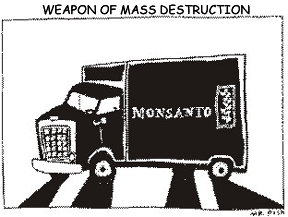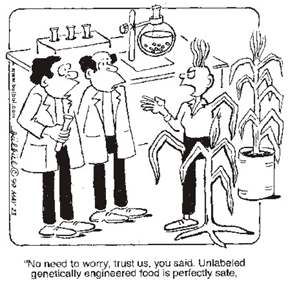|
Genetically engineered food was supposed to have heralded a second green revolution, producing more food and improving food
and nutritional security. However, existing genetically modified (GM) foods are not providing more food or nutrition. The
spread of GM foods reflects the spread of food dictatorship, not free and informed food choices. Contrary to claims made by
proponents, GM foods are undermining food and nutritional security, food sovereignty, and food democracy.
Food Security
Most of the current acreage under GM crops is planted with first generation GM crops based on herbicide resistance or
the introduction of Bt. toxin genes for pest control. Neither of these traits is about increasing crop yields. Herbicide
resistant genes allow higher tolerance to herbicides, hence increased herbicide use. Bt. toxin in crops is supposed to control
the bollworm, but it is leading to the rapid emergence of resistance as well as new pests.
Increased yield from genetically engineered crops is the most important argument used by the genetic engineering industry.
However, genetic engineering has actually led to a decline in yields. Bill Christanson, a U.S. soya bean farmer at the first
conference on Biodevastation held in St. Louis, the headquarters of Monsanto, in July 1998, said that in Missouri, genetically
engineered soya had a five bushel per acre decrease in yield. Ed Oplinger, professor of Agronomy at the University of Wiscousin,
has been carrying out yield trials on soya bean for 25 years. On the basis of data he collected in 12 states that grow 80
percent of U.S. soya, he found genetically engineered soya beans had 4 percent lower yields than conventional varieties.

In a study by Marc Lappe and Britt Bailey, in 30 out of 38 varieties, conventional soya beans outperformed the transgenic
ones, with an overall drop in yield of 10 percent compared to conventional varieties (Against the Grain, 1999). Dr. Charles
Benbrook reported a 6-7 percent decline in yields engineered for resistance to the herbicide Roundup, on the basis of 8,200
university-based varietal trials in 1998. If not reversed by future breeding enhancements, this downward shift in soya bean
yields could emerge as the most significant decline in a major crop ever associated with a single genetic modification.
In India, Bt. cotton yields have been dramatically less than promised in the first year of planting. Surveys show that in
Maharashtra and Andhra Pradesh, non-Bt. varieties yielded ten quintals/acre, while Bt yields were two quintals/acre. In Madhya
Pradesh, non-Bt. varieties gave 7.05 quintals/acre while Bt. gave 4.01 quintals/acre. In Karnataka, non-Bt. gene 7 quintals/acre
while Bt. cotton yield was 382 quintals per acre. GM crops are not giving increased yields in farmers fields. Yields have
declined by 50 to 60 percent. The higher yields only exist in falsified corporate generated data.
A recently published paper in Science, February 7, 2003, by Matin Qaim and David Zilberman, has been used to falsely claim
that yields of Bt. cotton in commercial planting in India in 2002 were higher than in non-Bt. Cotton. This so called scientific
study creates two false impressions. It is not based on independently generated scientific data from farmers fields, but on
unverified "confidential data" provided by the Monsanto-Mahyco corporation, which is involved in selling Bt. cotton
seeds. Secondly, while the study is based on corporate data of the 2001 trials, it has been used to falsely claim "and
increased fields in the commercial planting of 2002. However, all independent studies show a drop in yields. Even the so called
"expert group" that accompanied Monsanto-Mahyco representatives to assess the commercial planting falsified data.
Second generation crops such as "golden rice" and "protein potatoes,"which are being offered as future
promises for increasing nutrition in the face of environmental critiques of herbicide resistant and Bt. toxin crops, also
fail in improving nutritional security.
Under the Indo-Swiss Technology Transfer agreement for vitamin A rice (golden rice), genetically engineered rice produces
70 times less vitamin A than other sources of food.
Similarly, the recently announced protein potato will reduce protein availability in India. As reported in the New Scientist
(January 2, 2003), the plan was presented at a conference in London by G. Padmanabhan who, as director of India's prestigious
Indian Institute of Science, had signed a secret deal with Monsanto, which his fellow scientists of the Institute knew nothing
about.
The GM potato, which has amaranth genes, was developed by Asis Datta of the Jawaharlal Nehru University in New Delhi,
who had earlier tried to sell and patent the same genetic engineering technology by introducing amaranth genes into rice.
Datta has also been on the Department of Biotechnology committee, which gives grants and Biosafety clearances. He is thus
both the giver and receiver of biotechnology funds and regulator and practitioner. Such conflicts of interest are pervasive
in agricultural biotechnology.
The genetically engineered potato that is now being offered as part of an anti-hunger strategy has genes from amaranth.
Amaranth is available in huge quantities in the Indian Himalaya. Navdanya, our organic movement, is increasing the use of
amaranth products, such as ready-to- eat cereals, flour, baked goods' beyond the traditional use of amaranth as a fasting
food.
When compared to bringing nutrition through grains like amaranth, genetically engineered potatoes will create malnutrition
because they will deny to vulnerable children the other nutrients available in grain amaranth and not available in potato.
(The above table gives the comparative nutrition from amaranth and potatoes.) Thus genetically engineered potato will spread
iron deficiency and calcium deficiency in children. A much smarter option is to spread the cultivation and use of amazing
grains like amaranth. The ancient people of the Andes treated amaranth as sacred. In India it is called "ramdana"
or god's own grain. The root word "amara" in both Greek and Sanskrit, means eternal or deathless.

Datta and Padmanabhan's recipe for a GM potato is one of pushing out the amaranth from cultivation and consumption and spreading
a monoculture of potato cultivation and consumption. This is a recipe for biodiversity erosion and hunger creation. It is
a product of what I have called a "monoculture of the mind."
In any case, amaranth is not the only source of protein in India's rich biodiversity and cuisine. Our "dals"
pulses, and legumes that are a staple with rice as dal- chawal and with wheat as dal-roti are rich in protein.
The consumption of dals and pulses provides much higher levels of proteins than genetically engineered potatoes can. Pulses
are also necessary for sustainable agriculture, since they are nitrogen-fixing crops and provide an ecological alternative
to chemical nitrogenous fertilizers. Pulses have been made expensive by being made scarce through the spread of green revolution
mono-cultures of wheat and rice. In Punjab alone, the area under pulses went down from 13.38 percent to 3.48 percent during
1966-67 to 1985-86. Traditional agriculture was based on mixtures of cereals and pulses. New initiatives like Navdanya are
rejuvenating mixed cropping with pulses to increase both nutritional security and ecological security.
GM foods are intrinsically linked to food dictatorship. The first level of control comes from the fact that a handful
of gene giants "Monsanto, Syngenta, Aventis, Dow, Dupont" control agricultural biotechnology. The second level of
controlocomes from intellectual property and patent monopolies over GM seeds and plants. The third level of control is created
by stifling freedom of information and choice. GM crops are only spreading where farmers are denied freedom of information
and freedom of choice because of corporate control and dependency. GM foods are entering the food chain where consumers are
denied the right to know and the right to choose. U.S. farmers are the most trapped under corporate control of inputs and
marketing.
U.S. citizens have been denied food freedom and food democracy by corporations preventing labeling of GM foods.
In Europe and Japan, consumers have freedom of choice and it is that freedom which has prevented GM foods from flooding
the market.
In Africa, a democratic process led to Zambia's refusal to accept GM food and the Zambian president condemned the FAO,
WHO, and World Food Program for being irresponsible in supporting the U.S. He said, "We may be poor and experiencing
food shortages, but are not ready to expose people to ill-defined risks." He pleaded that Zambians not be used as guinea
pigs.
Southern Africa has been made a victim of drought and famine under the joint impact of climate change and structural adjustment
programs. The World Bank has forced countries to destroy and dismantle their food security systems. Faced with severe drought,
lack of food security is creating conditions of famine. More than 300,000 people face starvation. Famine caused by western
powers is now being used to market GMOs through food aid. Zambia, Zimbabwe, and Mozambique have refused to accept GMOs in
food aid. The WHO was mobilized to force African countries to accept GM food. The U.S. government made the force feeding of
Africans with GMOs a major issue. When Colin Powell, representing President Bush, kept insisting on African countries importing
GM food from the U.S. in the closing plenary of the Earth Summit, he was heckled by both NGOs and governments. African farmers
had come to Johannesburg with alternatives—small scale, indigenous-based on farmers rights to land, water, and seed.
The Earth Summit in Johannesburg 2002, organized ten years after the Rio Summit, which gave us the Convention on Biological
Diversity and the Biosafety Protocol, was also reduced to a marketplace for pushing biotech on Africa. Hundreds of African
farmers and government representatives condemned the U.S. pressure to force GM contaminated food aid. As civil society representatives
from Africa stated, "We, African Civil Society groups, participants to the World Summit on Sustainable Development, composed
of more than 45 African countries, join hands with the Zambian and Zimbabwean governments and their people in rejecting GE
contaminated food for our starving brothers and sisters:
"We refuse to be used as the dumping ground for contaminated food, rejected by the Northern countries; and we are
enraged by the emotional blackmail of vulnerable people in need, being used in this way.
"The starvation period is anticipated to begin early in 2003, so that there is enough time to source uncontaminated
food.
"There is enough food in the rest of Africa (already offered by Tanzania and Uganda) to provide food for the drought
areas.
"Our responses is to strengthen solidarity and self-reliance with in Africa, in the face of this next wave of colonization,
through GE technologies, which aim to control our agricultural systems, through the manipulation of seed by corporations.
"We will stand together in preventing our continent from being contaminated by genetically engineered crops, as a
responsibility to our future generation.”
The dumping of GM food through food aid was the most controversial issue at the World Summit on Sustainable Development.
Instead of listening to the voices of the people of Africa and respecting their food sovereignty, Colin Powell chastised the
governments of Southern Africa saying, "In the face of famine, several governments in Southern Africa have prevented
critical food assistance from being distributed to the hungry by rejecting biotech corn."
It is not just Southern Africa where food aid is being used to create markets for the Biotech industry. After a devastating
cyclone in India that killed 30,000 people, corn-soya blend was distributed as food aid even though the people of Orissa eat
rice. Our organization, the Research Foundation for Science, Technology and Ecology had the corn-soya mixture analyzed and
found it to be genetically engineered, in total violation of GM laws in India. The women and children welfare programs financed
by the World Bank are increasingly being used to subsidize the biotech industry and open up markets for GM goods through the
back door.
The World Food Program has been distributing transgenic food for seven years without informing recipient countries and
often in violation of the national laws of these countries.
On June 10, 2002, the Bolivian Forum on Environment and Development found that a sample of USAID food aid tested positive
for the presence of Starlink maize, a GM corn not approved for human consumption, due to health concerns over possible allergenic
effects. Aid to Columbia was found to be 90 percent transgenic.
There are major issues related to food aid being used to market biotech products. First, there is the question of the
growing hunger and food scarcity as a result of the destruction of ecological security and food security. The solution to
food insecurity is to strengthen ecological resilience of farming systems through biodiversity and sustainable agriculture
and the economic resilience of local communities through food sovereignty.
Second, when countries facing scarcity want non-GM food, their choice needs to be respected in genuinely humanitarian
relief. There is enough non-GM food in the world. Southern Africa needed a million tons of food grain to tide over its food
crisis: 1.16 million tons of non-GM maize is available in Kenya, Tanzania, Uganda, and South Africa. More than double the
amount is available on the world market. The EU announced that it would provide Southern Africa with 30 million Euro to access
GM free food for aid. India has 65 million tons of non-GM food stockpiled which can be provided for less than US$0.10 a kilo.
Alternatives to GM food are plenty. Coercion in periods of emergency is inhuman action, not humanitarian aid.
Recently, India rejected a shipment of 10,000 tons of corn for food aid because it was contaminated with Starlink corn.
The paradox of India importing increasing amounts of food for aid, while 65 million tons rot in storage, shows that food
insecurity is a result of erosion of food sovereignty and food democracy, not of food security. It is the democracy deficit
that is allowing the spread of GM foods. GM foods do not represent technological success, but democratic failure. Food safety
and food security is a democratic challenge for North and South, for rich and poor, for producers and consumers. The right
to safe, good, and adequate food is a universal human right and the basis of food democracy. No society can call itself free
if it operates in violation of food democracy.
|

